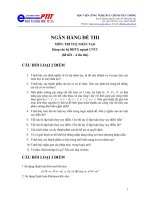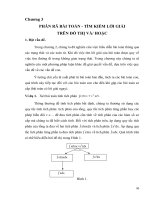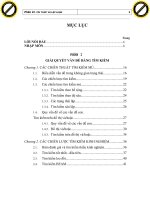Slide trí tuệ nhân tạo fol
Bạn đang xem bản rút gọn của tài liệu. Xem và tải ngay bản đầy đủ của tài liệu tại đây (501.71 KB, 28 trang )
Introduction to
Artificial Intelligence
Chapter 3: Knowledge
Representation and Reasoning
(3) First-order Logic
Nguyễn Hải Minh, Ph.D
07/10/2018
Nguyễn Hải Minh @ FIT - HCMUS
CuuDuongThanCong.com
1
/>
Outline
❑Why First Order Logic (FOL)?
❑Syntax and semantics of FOL
❑Using FOL
❑Wumpus world in FOL
❑Knowledge engineering in FOL
07/10/2018
Nguyễn Hải Minh @ FIT - HCMUS
CuuDuongThanCong.com
2
/>
Pros and cons of propositional logic
❑Propositional logic is declarative
❑Propositional logic allows partial/disjunctive/negated
information
❑Propositional logic is compositional:
o meaning of B1,1 P1,2 is derived from meaning of B1,1 and of P1,2
❑Meaning in propositional logic is context-independent
o unlike natural language, where meaning depends on context
❑Propositional logic has very limited expressive power
o E.g., cannot say "pits cause breezes in adjacent squares“
• except by writing one sentence for each square
• B1,1 ⇔ (P1,2 ∨ P2,1), B2,2 ⇔ (P1,2 ∨ P2,1 ∨ P3,1 ∨ P1,3)
07/10/2018
Nguyễn Hải Minh @ FIT - HCMUS
CuuDuongThanCong.com
3
/>
Pros and cons of propositional logic
❑Sentences that can not be represented
using Propositional logic
o Because Socrates is a human, Socrates dies.
o When a box is painted blue, it becomes a blue
box
o A student can log in to Moodles if he is given
an account and the teacher adds him to the
class.
Facts about some or all of
the objects in the universe
General rules
07/10/2018
Nguyễn Hải Minh @ FIT - HCMUS
CuuDuongThanCong.com
4
/>
First-order logic
❑Whereas propositional logic assumes the world
contains facts,
❑First-order logic (like natural language)
assumes the world contains
o Objects: people, houses, numbers, colors, Bill Gates,
games, wars, …
o Relations:
• Properties: red, round, prime,
• n-ary relations: brother of, bigger than, part of,
comes between, …plus,
o Functions: father of, best friend, one more than, …
07/10/2018
Nguyễn Hải Minh @ FIT - HCMUS
CuuDuongThanCong.com
5
/>
First-order logic – Example
1. “One plus two equals three.”
o Object: one, two, three, one plus two
o Relation: equal
o Function: plus
2. “Squares neighboring the wumpus are smelly.”
o Object: squares, Wumpus
o Property: smelly
o Relation: neighboring
3. “Intelligent AlphaGo beat the world champion in
2016.”
o Object: AlphaGo, world champion, 2016
o Relation: beat
o Property: intelligent
07/10/2018
Nguyễn Hải Minh @ FIT - HCMUS
CuuDuongThanCong.com
6
/>
5 Types of Logics
Language
Ontological Commitment
(What exists in the world)
Epistemological
Commitment (What an
agent believes about facts)
Propositional logic
Facts
True/false/unknown
First-order logic
Facts, objects, relations
True/false/unknown
Temporal logic
Facts, objects, relations,
time
True/false/unknown
Probability logic
Facts
Degree of belief ∈ [0,1]
Fuzzy logic
Facts with degree of truth
∈ [0,1]
Known interval value
Formal languages and their ontological and
epistemological commitments of 5 types of logics
07/10/2018
Nguyễn Hải Minh @ FIT - HCMUS
CuuDuongThanCong.com
7
/>
Models for FOL
❑FOL models have objects in them
o Domain of a model is the set of objects it
contains
o Domain must not be empty
o It doesn’t matter what these objects are,
but how many there are in each
particular model
07/10/2018
Nguyễn Hải Minh @ FIT - HCMUS
CuuDuongThanCong.com
8
/>
Models for FOL: Example
▪
▪
▪
▪
5 objects
2 binary relations
3 unary relations
1 unary function
07/10/2018
Nguyễn Hải Minh @ FIT - HCMUS
CuuDuongThanCong.com
9
/>
Models for FOL: Example
❑5 objects:
o
o
o
o
o
Richard (King of England 1189-1199)
John (King of England 1199-1215)
The left leg of Richard
The left leg of John
A crown
❑Relations:
o Binary relations:
• The brotherhood relation: {<Richard, John>. <John, Richard>}
• The “on head” relation: {<The crown, John>}
o Unary relations: “person”, “king”, “crown”
o Functions: “left leg”
• <Richard> → Richard’s left leg
• <John> → John’s left leg
07/10/2018
Nguyễn Hải Minh @ FIT - HCMUS
CuuDuongThanCong.com
10
/>
Syntax of FOL: Basic elements
❑Constants
❑Predicates
❑Functions
❑Variables
❑Connectives
❑Equality
❑Quantifiers
07/10/2018
AlphaGo, John, US, ...
Brother, >,...
Sqrt, LeftLegOf,...
x, y, a, b,...
, , , ,
=
,
Nguyễn Hải Minh @ FIT - HCMUS
CuuDuongThanCong.com
11
/>
Syntax of FOL: Terms
❑A term: a logical expression that
refers to an object.
o Constant symbols: John
o Function symbols: LeftLeg(John)
Term = function(term1,...,termn) or constant or variable
07/10/2018
Nguyễn Hải Minh @ FIT - HCMUS
CuuDuongThanCong.com
12
/>
Syntax of FOL: Atomic Sentences
❑An atomic sentence (Atom) is formed
from a predicate symbol followed by a
parenthesized list of terms
o Brother(Richard, John)
o Married(Father(Richard), Mother(John))
Atomic sentence = predicate(term1,...,termn)
07/10/2018
Nguyễn Hải Minh @ FIT - HCMUS
CuuDuongThanCong.com
13
/>
Syntax of FOL: Complex Sentences
❑Complex sentences are made from atomic
sentences using connectives
o ¬Brother (LeftLeg(Richard), John)
o Brother (Richard , John) ∧ Brother (John,
Richard)
o King(Richard ) ∨ King(John)
o ¬King(Richard) ⇒ King(John)
o…
07/10/2018
Nguyễn Hải Minh @ FIT - HCMUS
CuuDuongThanCong.com
14
/>
Truth in first-order logic
❑Sentences are true with respect to a model and
an interpretation
❑Model contains objects (domain elements) and
relations among them
❑Interpretation specifies referents for
constant symbols → objects
predicate symbols → relations
function symbols → functional relations
❑An atomic sentence predicate(term1,...,termn) is
true
iff the objects referred to by term1,...,termn
are in the relation referred to by predicate
07/10/2018
Nguyễn Hải Minh @ FIT - HCMUS
CuuDuongThanCong.com
15
/>
Syntax of FOL: Universal Quantification
<variables> <sentence>
❑: For all…
❑E.g., “All kings are persons”: x King(x) ⇒ Person(x)
“Students of FIT are intelligent: x Student(x, FIT) ⇒ Smart(x)
x P is true in a model m iff P is true with x being
each possible object in the model
→Equivalent to the conjunction of instantiations of P
Student(Lan, FIT) ⇒ Smart(Lan)
Student(Tuan, FIT) ⇒ Smart(Tuan)
Student(Long, FIT) ⇒ Smart(Long)
…
07/10/2018
Nguyễn Hải Minh @ FIT - HCMUS
CuuDuongThanCong.com
16
/>
A common mistake to avoid
❑Typically, is the main connective with
❑Common mistake: using as the main
connective with :
x Student(x, FIT) Smart(x)
means “Everyone is a student of FIT and everyone is
smart”
07/10/2018
Nguyễn Hải Minh @ FIT - HCMUS
CuuDuongThanCong.com
17
/>
Syntax of FOL: Existential Quantification
<variables> <sentence>
❑: Some of the collection
❑E.g., “Some students of FIT are intelligent:
x Student(x, FIT) ⇒ Smart(x)
x P is true in a model m iff P is true with x being
some possible object in the model
→Equivalent to the disjunction of instantiations of P
Student(Lan, FIT) Smart(Lan)
Student(Tuan, FIT) Smart(Tuan)
Student(Long, Fit) Smart(Long)
…
07/10/2018
Nguyễn Hải Minh @ FIT - HCMUS
CuuDuongThanCong.com
18
/>
Another common mistake to avoid
❑Typically, is the main connective with
❑Common mistake: using as the main
connective with :
x Student(x, FIT) Smart(x)
is true if there is anyone who is not at FIT!
07/10/2018
Nguyễn Hải Minh @ FIT - HCMUS
CuuDuongThanCong.com
19
/>
Properties of quantifiers
❑x y is the same as y x
❑x y is the same as y x
❑x y is not the same as y x
o x y Loves(x,y)
→ “There is a person who loves everyone in the world”
o y x Loves(x,y)
→ “Everyone in the world is loved by at least one
person”
❑Quantifier duality: each can be expressed using the
other
o x Likes(x,IceCream) x Likes(x,IceCream)
o x Likes(x,Broccoli) x Likes(x,Broccoli)
07/10/2018
Nguyễn Hải Minh @ FIT - HCMUS
CuuDuongThanCong.com
20
/>
Equality
❑term1 = term2 is true under a given
interpretation if and only if term1 and term2 refer
to the same object
❑E.g., definition of Sibling in terms of Parent:
o x,y Sibling(x,y) [(x = y) m,f (m = f)
Parent(m,x) Parent(f,x) Parent(m,y)
Parent(f,y)]
07/10/2018
Nguyễn Hải Minh @ FIT - HCMUS
CuuDuongThanCong.com
21
/>
Using FOL: The kinship domain
❑Brothers are siblings
o x,y Brother(x,y) Sibling(x,y)
❑One's mother is one's female parent
o m,c Mother(c) = m (Female(m) Parent(m,c))
❑“Sibling” is symmetric
o x,y Sibling(x,y) Sibling(y,x)
❑DIY:
o
o
o
o
Parent and child are inverse relations
A grandparent is a parent of one’s parent
A sibling is another child of one’s parent
One’s husband is one’s male spouse
07/10/2018
Nguyễn Hải Minh @ FIT - HCMUS
CuuDuongThanCong.com
22
/>
Using FOL: The set domain
❑Sets are the empty set and those made by adjoining something
to a set:
o s Set(s) (s = {} ) (x,s2 Set(s2) s = {x|s2})
❑The empty set has no elements adjoined into it.
o x,s {x|s} = {}
❑Adjoining an element already in the set has no effect:
o x,s x s s = {x|s}
❑The only members of a set are the elements that were adjoined
into it.
o x,s x s [ y,s2} (s = {y|s2} (x = y x s2))]
❑Can you interpret the following sentences?
o s1,s2 s1 s2 (x x s1 x s2)
o s1,s2 (s1 = s2) (s1 s2 s2 s1)
o x,s1,s2 x (s1 s2) (x s1 x s2)
Nguyễn
o07/10/2018
x,s1,s2 x (s1 s2) (x
s1HảiMinhx @FIT s- HCMUS
2)
CuuDuongThanCong.com
23
/>
Using FOL: The Wumpus World
❑Typical percept sentence:
o Percept([Stench, Breeze, Glitter, None, None]. 5)
❑Actions:
o Turn(Right), Turn(Left), Forward, Shoot, Grab,
Release, Climb
❑To determine the best action, construct query:
o ASKVARS(∃a BestAction(a, 5))
o Returns a binding list such as {a/Grab}
07/10/2018
Nguyễn Hải Minh @ FIT - HCMUS
CuuDuongThanCong.com
24
/>
QUIZ
Write this sentence using FOL:
“Students can miss some classes of all courses, and
they can miss all classes of some courses, but they
cannot miss all classes of all courses.”
Giving the following predicates:
• Student(x) = x is a student
• Class(z, y) = z is a class of course y
• Miss(x, z) = x miss class z
Deadline: 20h today on Moodles
07/10/2018
Nguyễn Hải Minh @ FIT - HCMUS
CuuDuongThanCong.com
25
/>









